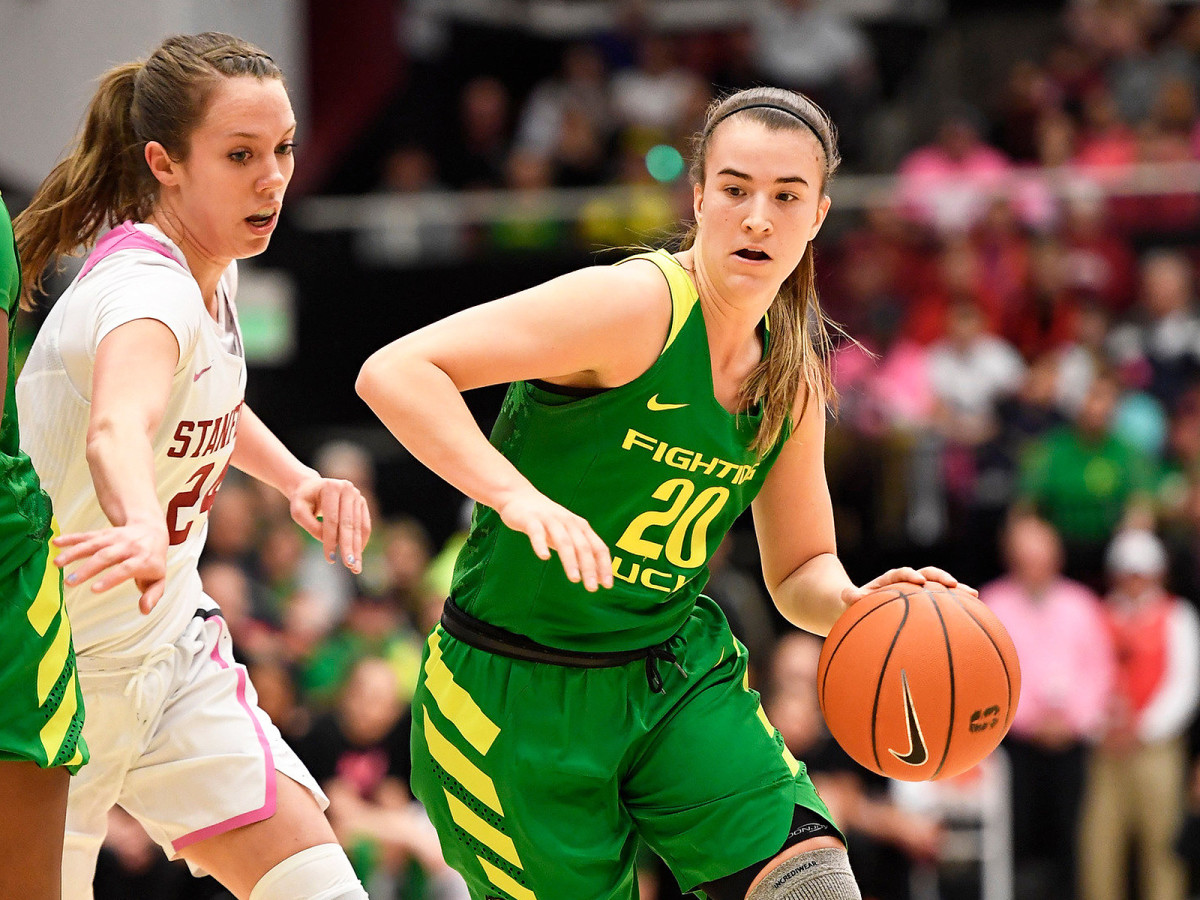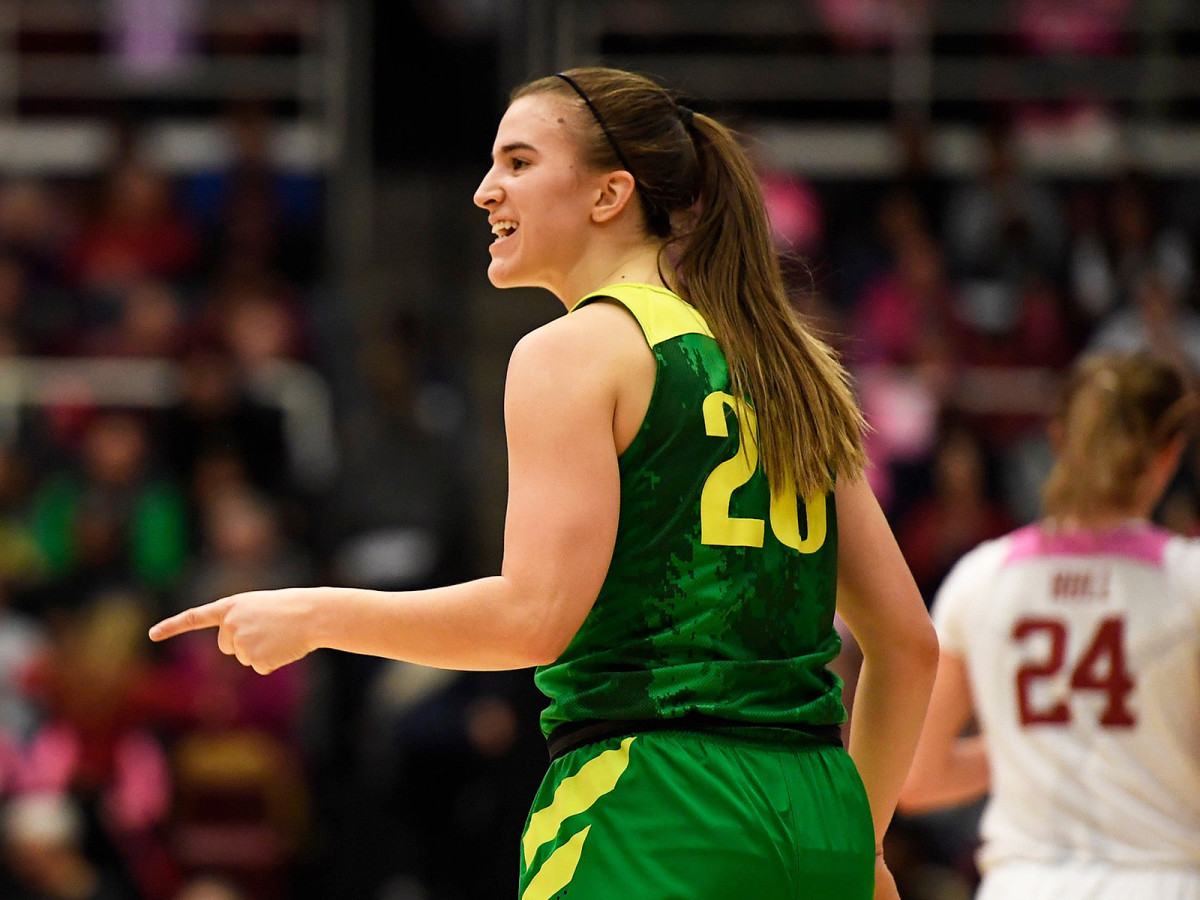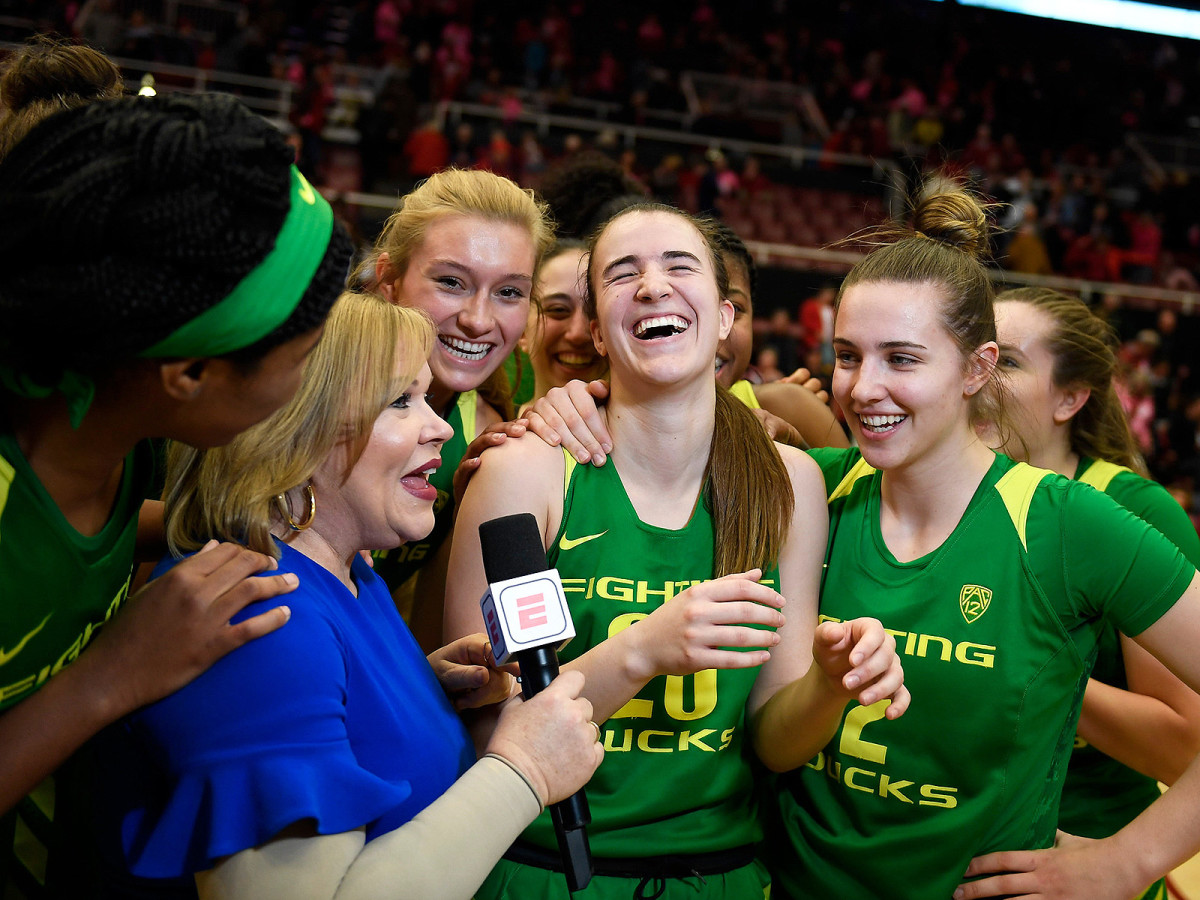The Making of Sabrina Ionescu, Oregon's Lean, Mean, Triple-Double Machine

*****
This story appears in the March 11, 2019, issue of Sports Illustrated. For more great storytelling and in-depth analysis, subscribe to the magazine—and get up to 94% off the cover price. Click here for more.
In the 33rd minute of her 82nd career game, after Air Force guard Venessannah Itugbu missed a contested layup, Sabrina Ionescu snared the rebound with both hands and smiled. The rare display of emotion lasted barely a second before the 5' 11" junior guard lobbed a pass to Oregon teammate Erin Boley, who hit a three-pointer to put the Ducks up 73–32. The player whose rebound had given her the NCAA record (for men and women) for career triple doubles added another assist and a defensive rebound to her tally before she’d caught a single high five for her accomplishment.
The triple double—Ionescu had 17 points, 11 rebounds and 13 assists—was the 13th of her career, topping the mark that BYU’s Kyle Collinsworth set during his four-year, 140-game career, which ended in 2016. There was no celebration; Ionescu went home to the apartment across the street from Oregon’s basketball facility that she shares with her twin brother, Eddy. They broke down the game, and then Ionescu scrolled through her phone. She fretted over a Twitter post from a Louisville fan, who said the record shouldn’t count because the triple doubles hadn’t come against highly ranked teams. None of which is to say that Ionescu, who had been tied with Collinsworth for about five weeks, didn’t appreciate her accomplishment. “I just knew I wasn’t going to tie anyone’s record,” she says. “I just had to get that one more.”
Well, not just one. The next day, Dec. 21, she put up 13 points, 10 rebounds and 14 assists against UC Irvine.

The most versatile player in women’s college hoops was born 21 years ago to parents who’d barely heard of basketball, who took years to understand why their kids got to shoot two free throws on some fouls, but other times just one. Dan Ionescu and Liliana Blaj only learned about the sport that would become their daughter’s lifeblood when their oldest son, Andrei, picked it up at his school in Walnut Creek, Calif., a Bay Area suburb. That’s where Sabrina’s family settled after fleeing the 1989 Romanian Revolution, and it’s where she was born 18 minutes before Eddy, seven years after her parents emigrated. In Walnut Creek the Ionescu kids learned the hardscrabble ethos of their parents’ home country: You’ll earn nothing if you don’t work for it.
When they were three, the twins started playing basketball to keep up with Andrei, who is nine years older. In the summers while their parents worked, the twins haunted the Larkey Park court from morning until dusk. Dan, who owns a limousine company, would sometimes pick them up there in the evening, shining his headlights toward the hoop to afford his kids a few extra minutes of ball. On those long summer days they’d play anyone who challenged them. As third- or fourth-graders, they beat a much older duo in a game of H‑O‑R-S-E, an achievement made even more memorable by the 7-Eleven Slurpees they won off the teenagers. By the time the twins were in middle school, they’d joined club teams, but they were still inseparable. Sabrina took her sneakers wherever she went; if Eddy and the boys needed another player, she would jump in. In sixth grade she was placed on a team of eighth-grade girls; between them and Eddy’s friends, she was almost always physically overmatched.
To compete, Sabrina learned to read other players and prevent them from reading her. She perfected the no-look pass, delivering the ball perfectly to her teammates, who sometimes hadn’t realized they were open. On defense she was a pest, constantly waving her arms and frustrating opponents into making mistakes. “I didn’t treat her as a girl,” Eddy says. “I’d give her all the elbows. We’d fight. We’d throw punches. She was like my twin brother.”
More than a decade later, their sibling bond remains strong. Eddy played two seasons at City College of San Francisco before moving in 2018 to Oregon, where he hopes to walk on to the men’s team next season. Since arriving in Eugene, the 6' 6" small forward has resumed training with his sister—the Steph Curry to his Klay Thompson, he jokes.
That the Ducks have a player who can be mentioned in the same breath as a Splash Brother is significant. When Kelly Graves got the Ducks’ coaching job in 2014, he inherited a program that hadn’t had a winning conference record since 2004–05. He had led Gonzaga to 10 consecutive West Coast Conference championships but needed to recruit higher-caliber players to compete in the Pac-12. The No. 4 player in the 2016 class, Ionescu was MVP of the McDonald’s All-American Game and the USA Today Girls’ Basketball Player of the Year. On her visits to Oregon she felt at home with the program, and when she enrolled in mid-June of that year, she became the highest-ranked recruit in Ducks’ history.

Press pause on an Oregon basketball game, and Ionescu won’t be the first player to stand out. “If you hear triple-double queen or D-I basketball player, she’s not the first body type that comes to mind,” 6' 4" forward Ruthy Hebard says with a laugh. Ionescu’s frame is slender. Every day she pulls her long brown hair into a ponytail, straight and neat. Not a strand falls out of place.
Now press play, and good luck keeping up.
“To appreciate her, just focus in on nobody but her for a while,” Graves says. “She’s always moving. She’s always looking for an angle. She’s always doing something. She’s not the quickest kid. She just never rests. Therefore, her defender never rests. She’s always a step ahead of everybody.”
For Ionescu, basketball is a mental game; the physical element is an afterthought. Her hoops IQ was developed during those years of pickup hoops on the blacktop in California. Like many cerebral ballhandlers, she’s an exceptional passer, easily settling into a groove. “I kind of realize, I’ve passed six times and they’ve made it every time,” she says. “I start to feel it.”
When Ionescu is on a roll—which she nearly always is—so are her teammates. For the second straight season, all five starters average more than 10 points per game. It took the Ducks a little time to catch up with Ionescu’s pass-first style; now they know the passes are coming and can turn their heads before they get hit. They know it’s not safe to assume she’ll take a shot if she looks marginally open, or even mostly open. “Sometimes I’m like, Sabrina, shoot the ball,” Hebard says. “Don’t pass it to me.”
She does shoot, of course. Ionescu is hitting 45.2% of her field goal attempts, including 44.4% from three-point range. Ionescu isn’t going to miss out on a triple double because she didn’t score. “Points don’t matter,” says Graves, “because she can get those anytime.” She has been in double figures every game this season.
That leaves rebounding. Collinsworth, a 6' 6" former BYU star who now plays for the Raptors’ G League team, knows what it takes to put together a stat line. Like Ionescu, he’s dealing with a size disadvantage when it comes to the boards. “I think triple doubles, especially for guards, the key to get them is the ability to rebound,” Collinsworth says. “Rebounds for me are what gave me the energy; I’d get the rebound, and I’d push the break and find shooters.”
Ionescu learned to rebound where she learned to do every-thing else: on the playground. And like Collinsworth, boards were a way of triggering the offense. Older, stronger players were often reluctant to pass to her, so the point guard willed herself to get rebounds as a way to get the ball in her hands. Her 7.2 boards per game currently rank second on the Ducks and 10th in the conference.
Ionescu has taken one of the most exciting feats in the game and turned it into something Graves calls “pretty passé.” At least twice this year, Ionescu has had double-digit points, rebounds and assists—and another teammate has been named player of the game.
Still, there’s no denying who the force is that draws more than 6,000 fans, on average, to Oregon home games, the most in the Pac-12. Little girls shriek “Sabrina!” during timeouts, and requests for photos on campus come often.
Following a season in which Oregon finished 33–5 and ranked No. 5, the best year in program history, the Ducks have continued their climb. This year the Ducks won their first game at No. 11 Stanford since 1987, and in doing so they handed Cardinal coach Tara VanDerveer the worst defeat of her four-decade career. In the 88–48 rout, Ionescu had 27 points and was one rebound and two assists shy of a triple double. She didn’t come up short four games later. In a 96–78 blowout of USC on Feb. 24, Ionescu had 13 points, 12 rebounds and 13 assists to get her seventh triple double of the season. Not only is that an NCAA record—no women’s player has more than that in her career.
While at Gonzaga, Graves coached Courtney Vandersloot, the point guard who in 2011 became the only player in NCAA basketball history to finish her career with 2,000 points and 1,000 assists. He’s been thinking of her lately as Ionescu keeps churning. Assuming Ionescu plays roughly the same number of minutes this year and next that she played in 2017–18 (she logged 1,354), she’s on pace to finish her career with more than 2,600 points and 1,000 rebounds. At her usual rate, she’d also easily log 1,000 career assists—a combination no player in the history of the college game has ever achieved. “She’s got a chance to do something that’s iconic, that in our lifetimes might never be broken,” Graves says. “Who knows—maybe the all-around, positionless player [is] more prevalent now, but those are staggering numbers.”

After finishing the regular season 27–3, the Ducks can make a case for a No. 1 seed in the NCAA tournament. Whenever that run ends, Ionescu will have to decide if she wants to return for her senior season. Though it’s rare for a player to leave early for the WNBA, she’d be eligible to do so because she turns 22 in December—but that’s a conversation for another day, another month, after (she hopes) a title.
For now Ionescu is still grinding, still doing everything a coach would dream his best player might do. As she hustles down the court, hundreds of times a game and always a step ahead, she presses her lips into a stick-straight line. Only Eddy’s high, shrill whistle can break her concentration.
He doesn’t do it often. He knows better, after years of being berated by his sister for interfering in her process. But when he knows he’s seen something his sister hasn’t, Eddy purses his lips and lets rip. That was the case on Feb. 1, at the start of the fourth quarter of a tight game with then No. 14 Utah. Sabrina’s shot hadn’t been falling all night, and after halftime, she’d begun hanging back, playing distributor and letting her teammates take the shots. Utah’s center was playing five feet off his sister, Eddy noticed. It was time to pounce. When Sabrina looked over, Eddy yelled: “Bro, you need to shoot the ball before I throw my shoe at you.”
She heard him. She launched one from behind the arc. It was the first of two three-pointers she’d make in the fourth quarter, which would help the Ducks run away with the 87–65 win.
There was no smile, just those pursed lips and narrowed eyes, and the intensity of a woman who has no record to chase other than her own.
